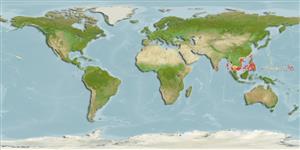Teleostei (teleosts) >
Eupercaria/misc (Various families in series Eupercaria) >
Labridae (Wrasses)
Etymology: Paracheilinus: Greek, para = the side of + Greek, chaite = hair + Greek, odous = teeth (Ref. 45335).
Eponymy: Dr Kent E Carpenter is Professor of Biological Sciences at Old Dominion University, Virginia, USA. [...] (Ref. 128868), visit book page.
More on authors: Randall & Lubbock.
Environment: milieu / climate zone / depth range / distribution range
Ecology
Marine; reef-associated; depth range 27 - 45 m (Ref. 9710), usually 27 - 45 m (Ref. 27115). Tropical; 25°N - 5°N
Western Pacific: Philippines, north to Taiwan and Iriomotejima, south to northern Bali and Flores (Ref. 37816). Recently recorded from Tonga (Ref. 53797). Replaced by Paracheilinus mccoskeri in the Indian Ocean (Ref. 37816).
Size / Weight / Age
Maturity: Lm ? range ? - ? cm
Max length : 8.0 cm TL male/unsexed; (Ref. 9710)
Dorsal spines (total): 9; Dorsal soft rays (total): 11; Anal spines: 3; Anal soft rays: 9; Vertebrae: 25. In males, color is generally orange (yellow- or red-orange); lower fourth of head and body pale yellow; 2-4 dorsal soft rays prolonged (every other ray beginning with first). Males larger and more colorful than females; color of males intensify during courtship. Female specimens light red, pale white ventrally. Median predorsal scales 4-6 (Ref. 2139). Penultimate dorsal soft ray of males 1.8-2.2 in HL; two short dark stripes beneath pectoral fin (Ref. 41634).
Found on bases of steep outer reef slopes, above coral or rubble (Ref. 9710). Forms schools. Maximum depth reported from Ref. 27115.
Life cycle and mating behavior
Maturity | Reproduction | Spawning | Eggs | Fecundity | Larvae
Oviparous, distinct pairing during breeding (Ref. 205).
Randall, J.E. and R. Lubbock, 1981. Labrid fishes of the genus Paracheilinus, with descriptions of three new species from the Philippines. Jap. J. Ichthyol. 28(1):19-30. (Ref. 2139)
IUCN Red List Status (Ref. 130435: Version 2024-1)
Threat to humans
Harmless
Human uses
Fisheries: commercial; aquarium: commercial
Tools
Special reports
Download XML
Internet sources
Estimates based on models
Preferred temperature (Ref.
123201): 23.9 - 28.2, mean 27.2 °C (based on 66 cells).
Phylogenetic diversity index (Ref.
82804): PD
50 = 0.5000 [Uniqueness, from 0.5 = low to 2.0 = high].
Bayesian length-weight: a=0.00977 (0.00470 - 0.02030), b=3.07 (2.90 - 3.24), in cm total length, based on LWR estimates for this (Sub)family-body shape (Ref.
93245).
Trophic level (Ref.
69278): 3.4 ±0.45 se; based on food items.
Resilience (Ref.
120179): High, minimum population doubling time less than 15 months (Preliminary K or Fecundity.).
Fishing Vulnerability (Ref.
59153): Low vulnerability (10 of 100).
